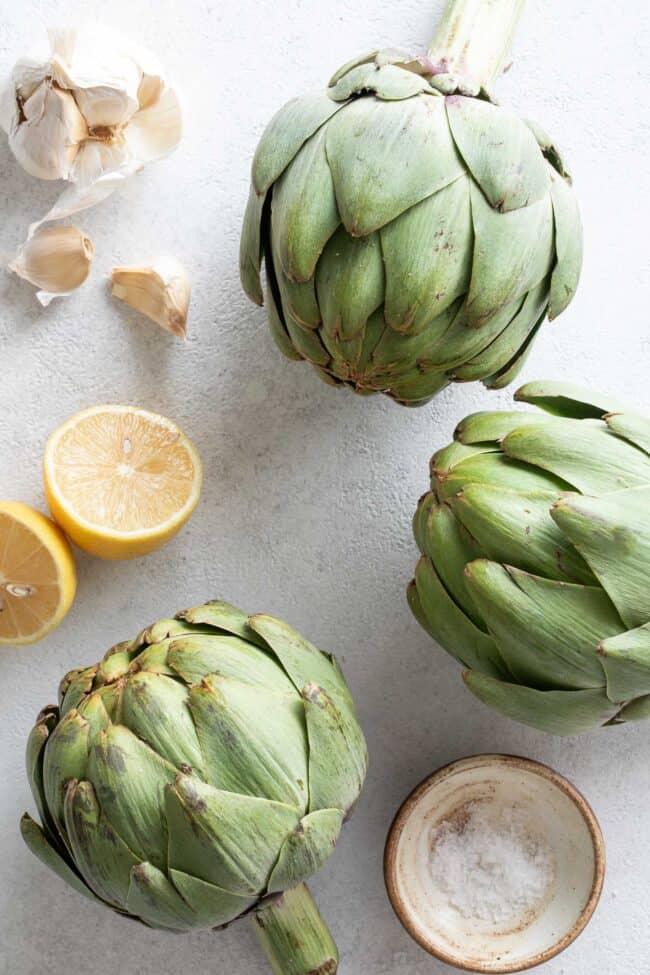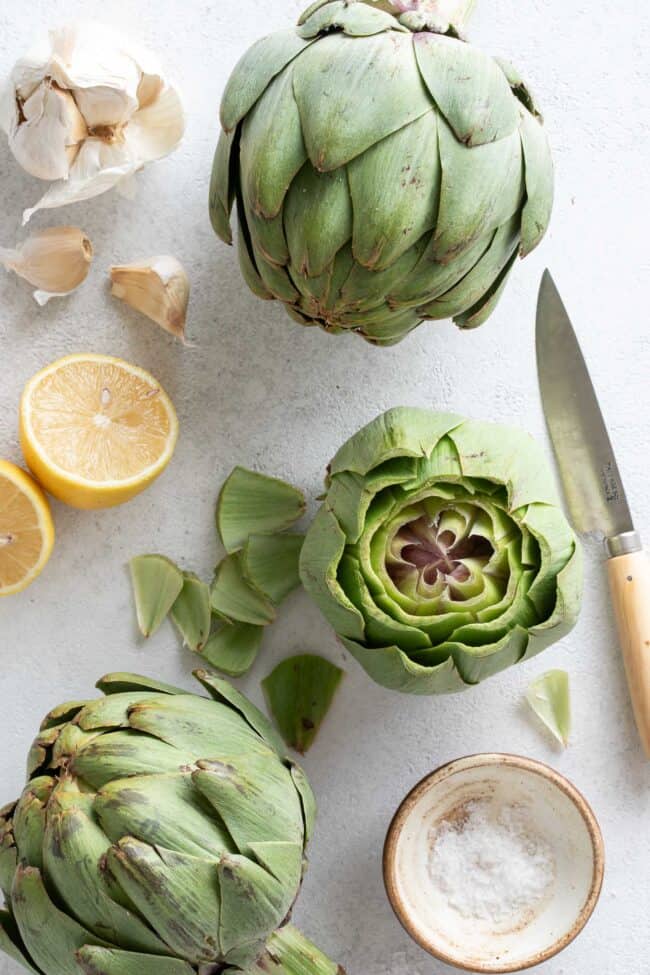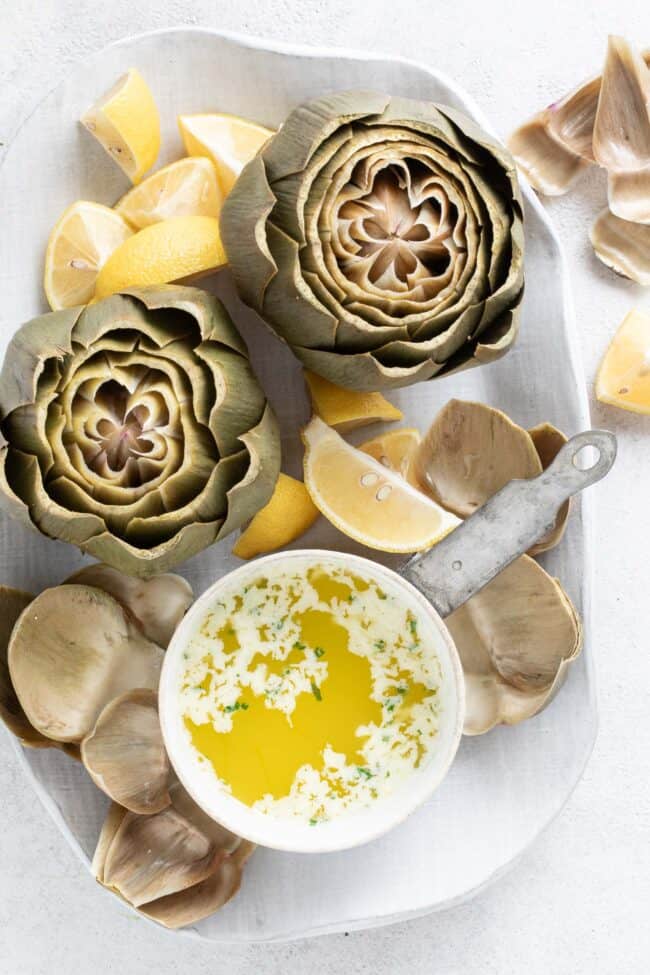How to Cook Artichokes
Learn How to Cook Artichokes like a pro with these easy boiled and steamed artichokes recipes. Cooking artichokes couldn’t be easier and they make a nice starter and a great side to serve with grilled chicken or fish.
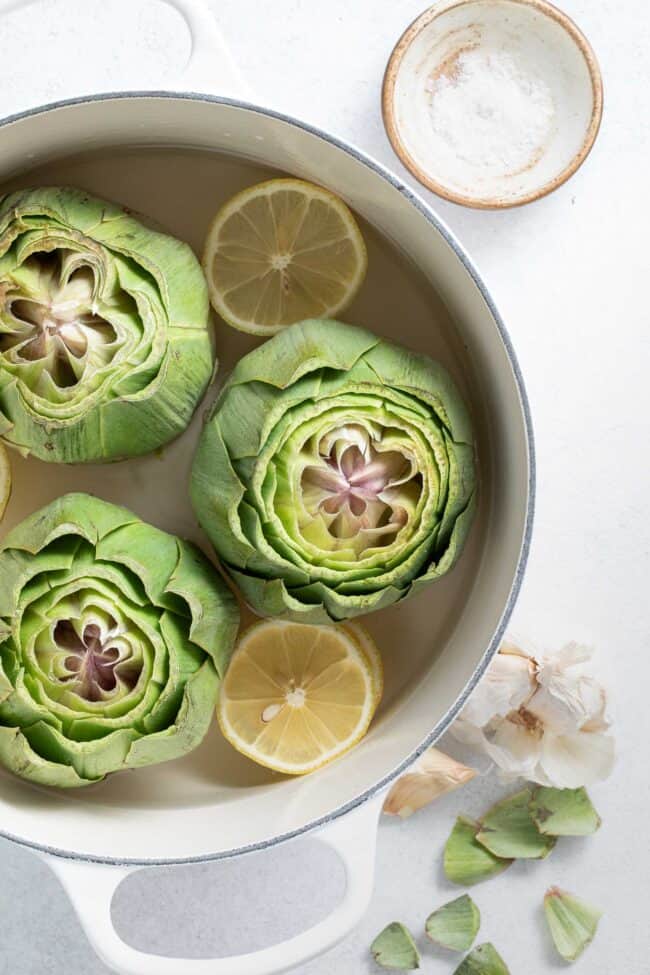
After you have learned how to cook artichokes, all that’s left to do is decide on your favorite dipping sauces to serve with them (and I have a few recommendations for you).
Steamed Artichokes Recipe
- Artichokes
- Lemon
- Garlic
- Extra-virgin olive oil
- Salt
Find printable recipe with measurements below.
How To Steam Artichokes
This steamed artichokes recipe is my favorite method of cooking artichokes.
- Slice off excess stem so the artichoke leaving 1/2 inch. If you want to leave a long stem for appearances, then cut off the very end and peel away the tough outer layer of the stem using a vegetable peeler.
- Tear away the smaller leaves at the bottom base of the artichoke.
- Using a pair of scissors clip off the tips of the leaves to remove the thorns.
- Using a sharp knife or a serrated knife slice about 1/2 inch to 3/4 inch off the top of the artichoke.
- Rinse the artichoke under cold water, spreading the leaves open a bit to allow the water to get inside.
- Add a couple of inches of water to a large Dutch oven. Drizzle in a tablespoon of olive oil and a pinch of salt to the water.
- Place a large steaming basket inside making sure the water doesn’t come above the basket.
- Add the artichokes to the steaming basket and bring the water to a boil over high heat. Reduce heat to a low simmer.
- Pace a lid on the pot and simmer on low for 30 to 35 minutes or until the leaves pull away easily from the base. The time may vary depending on the size of the artichoke with larger artichokes taking a little longer to cook. Be sure to watch the water level while cooking in case you need to add more water to the pot.
How To Boil Artichokes
- Prepare the artichokes the same as you would for steamed artichokes.
- Fill a large Dutch oven half full with water. Drizzle in a tablespoon of olive oil, 2-3 lemon slices and 1 clove garlic (peeled) and a pinch of salt to the water.
- Bring the water to a boil then using tongs lower the artichokes into the boiling water.
- Reduce heat to low and place lid on the pot.
- Cook for 20-35 minutes or until thick leaves pull away from the base easily. Timing will depend on the size of the artichokes.
- Remove artichokes from the pot and set them aside to drain of excess water.
Choosing The Best Artichokes
To tell if an artichoke is fresh, they should feel heavy and the leaves should be mostly closed and make a squeaky sound when you squeeze them in your hand.
Steaming vs Boiling Artichokes
Both steaming and boiling artichokes are easy cooking methods for artichokes but there are a few differences. Boiled artichokes are submerged in water and need to be drained before serving. When steaming artichokes, the artichokes are placed in a steamer basket fitted inside a pot filled with 2-3 inches of water and they can be served right from the pot to the plate (no draining necessary). Steamed artichokes also retain more nutrients that are often lost during the boiling process.
How To Eat Artichokes
- Peel one cooked petal away from the heart at a time.
- Dip the meaty end in butter, mayonnaise or your favorite sauce.
- Scrape the meaty end off with your teeth.
- Toss the rest of the petal in a bowl set out to gather petals that you will be throwing away.
- When you get to the inedible fuzzy choke, scrape away the layer of fuzz and cut the artichoke heart into pieces to dip in a sauce or enjoy it plain.
What Is An Artichoke Heart?
An artichoke heart is the tender meaty part at the center of the artichoke beneath all the leaves and the fuzzy choke. After all of the leaves have been pulled away you reach a fuzzy layer that is called the “choke”. The inedible choke is scraped away with a butter knife or a spoon to reach the meaty base of the artichoke which is called the “artichoke heart”.
Serving Suggestions
Steamed artichokes can be eaten plain, but they are often served with melted butter, mayonnaise or a dipping sauce.
More Resources
- How to Cook Quinoa
- How to Poach Chicken
- How to Make Tortilla Strips
- How to Make Bouquet Garni
- How to Cook Pinto Beans
- How to Cook Chickpeas
- How to Cook Black Beans
- How to Cook Lentils
- How to Bake Sweet Potatoes
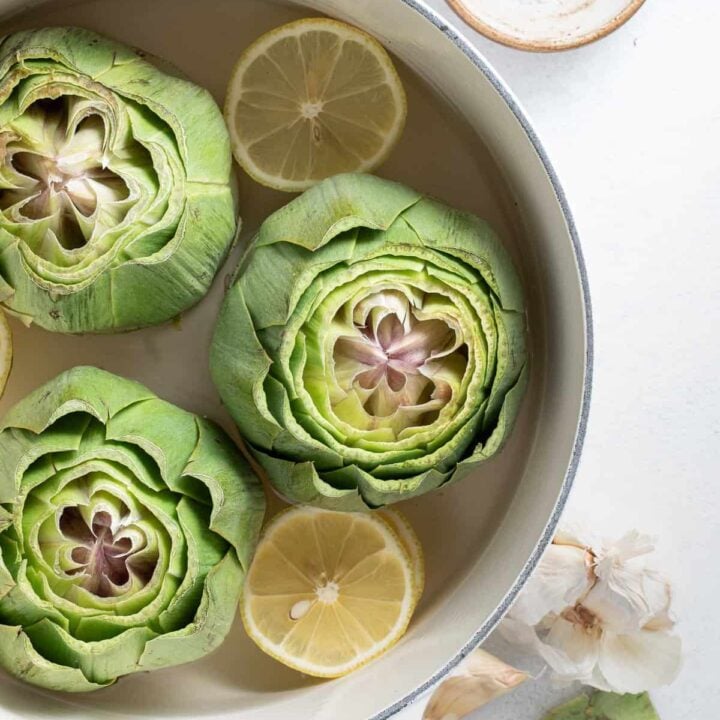
How to Cook Artichokes
Learn How to Cook Artichokes like a pro with these easy boiled and steamed artichokes recipes. Cooking artichokes couldn't be easier and they make a nice starter and a great side to serve with grilled chicken or fish.
Ingredients
- 4 large artichokes
- 1 tablespoon extra-virgin olive oil
- 1 garlic clove
- Lemon slices
- Pinch of salt
Instructions
Prepare Artichokes
- Slice off excess stem so the artichoke leaving 1/2 inch. If you want to leave a long stem for appearances, then cut off the very end and peel away the tough outer layer of the stem using a vegetable peeler.
- Tear away the smaller leaves at the bottom base of the artichoke.
- Using a pair of scissors clip off the tips of the leaves to remove the thorns.
- Using a sharp knife or serrated knife slice about 1/2 inch to 3/4 inch off the top of the artichoke.
- Since the artichoke under cold water, spreading the leaves open a bit to allow the water to get inside.
How To Steam Artichokes
- Add a couple of inches of water to a large Dutch oven. Drop in a few slices of lemon, a tablespoon of olive oil and a pinch of salt to the water.
- Place a large steaming basket inside.
- Add the artichokes to the steaming basket and bring the water to a boil over high heat. Reduce heat to a low simmer. Be sure to watch the water level while cooking in case you need to add more water to the pot.
- Pace a lid on the pot and simmer on low for 30 to 35 minutes or until the leaves pull away easily. The time may vary depending on the size of the artichoke with larger artichokes taking a little longer to cook.
How To Boil Artichokes
- Prepare the artichokes the same as you would for steamed artichokes.
- Fill a large Dutch oven half full with water. Drizzle in a tablespoon of olive oil, 2-3 lemon slices and 1 clove garlic (peeled) and a pinch of salt to the water.
- Bring the water to a boil then using tongs lower the artichokes into the boiling water.
- Reduce heat to low and place lid on the pot.
- Cook for 20-35 minutes or until thick leaves pull away from the base easily. Timing will depend on the size of the artichokes.
- Remove artichokes from the pot and set them aside to drain excess water.
Notes
Choosing The Best Artichokes
To tell if an artichoke is fresh, they should feel heavy and the leaves should be mostly closed and make a squeaky sound when you squeeze them in your hand.
Steaming vs Boiling Artichokes
Both steaming and boiling artichokes are easy cooking methods for artichokes but there are a few differences. Boiled artichokes are submerged in water and need to be drained before serving. When steaming artichokes, the artichokes are placed in a steamer basket fitted inside a pot filled with 2-3 inches of water and they can be served right from the pot to the plate (no draining necessary). Steamed artichokes also retain more nutrients that are often lost during the boiling process.
How To Eat Artichokes
- Peel one cooked petal away from the heart at a time.
- Dip the meaty end in butter, mayonnaise or your favorite sauce.
- Scrape the meaty end off with your teeth.
- Toss the rest of the petal in a bowl set out to gather petals that you will be throwing away.
- When you get to the inedible fuzzy choke, scrape away the layer of fuzz and cut the artichoke heart into pieces to dip in a sauce or enjoy it plain.
Nutrition Information:
Yield:
4Serving Size:
1Amount Per Serving: Calories: 95Total Fat: 4gSaturated Fat: 1gTrans Fat: 0gUnsaturated Fat: 3gCholesterol: 0mgSodium: 105mgCarbohydrates: 15gFiber: 7gSugar: 1gProtein: 4g
theharvestkitchen.com attempts to provide accurate information, however, this nutritional information is provided as a courtesy and is an estimate only. The nutritional information provided comes from online sources and calculations. See full disclaimer on About page.
